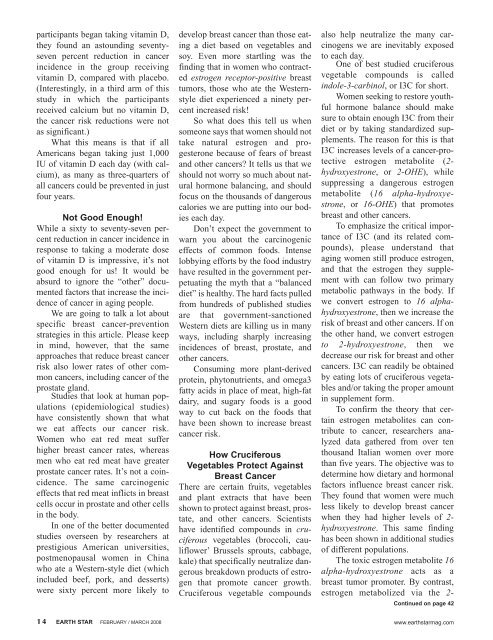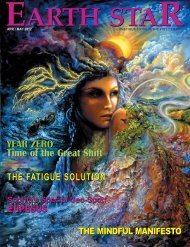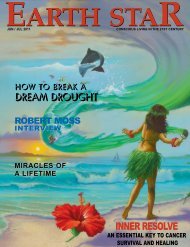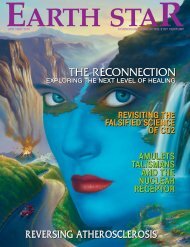GREGG BRADEN GREGG BRADEN - Earthstar
GREGG BRADEN GREGG BRADEN - Earthstar
GREGG BRADEN GREGG BRADEN - Earthstar
- No tags were found...
You also want an ePaper? Increase the reach of your titles
YUMPU automatically turns print PDFs into web optimized ePapers that Google loves.
participants began taking vitamin D,they found an astounding seventysevenpercent reduction in cancerincidence in the group receivingvitamin D, compared with placebo.(Interestingly, in a third arm of thisstudy in which the participantsreceived calcium but no vitamin D,the cancer risk reductions were notas significant.)What this means is that if allAmericans began taking just 1,000IU of vitamin D each day (with calcium),as many as three-quarters ofall cancers could be prevented in justfour years.Not Good Enough!While a sixty to seventy-seven percentreduction in cancer incidence inresponse to taking a moderate doseof vitamin D is impressive, it’s notgood enough for us! It would beabsurd to ignore the “other” documentedfactors that increase the incidenceof cancer in aging people.We are going to talk a lot aboutspecific breast cancer-preventionstrategies in this article. Please keepin mind, however, that the sameapproaches that reduce breast cancerrisk also lower rates of other commoncancers, including cancer of theprostate gland.Studies that look at human populations(epidemiological studies)have consistently shown that whatwe eat affects our cancer risk.Women who eat red meat sufferhigher breast cancer rates, whereasmen who eat red meat have greaterprostate cancer rates. It’s not a coincidence.The same carcinogeniceffects that red meat inflicts in breastcells occur in prostate and other cellsin the body.In one of the better documentedstudies overseen by researchers atprestigious American universities,postmenopausal women in Chinawho ate a Western-style diet (whichincluded beef, pork, and desserts)were sixty percent more likely todevelop breast cancer than those eatinga diet based on vegetables andsoy. Even more startling was thefinding that in women who contractedestrogen receptor-positive breasttumors, those who ate the Westernstylediet experienced a ninety percentincreased risk!So what does this tell us whensomeone says that women should nottake natural estrogen and progesteronebecause of fears of breastand other cancers? It tells us that weshould not worry so much about naturalhormone balancing, and shouldfocus on the thousands of dangerouscalories we are putting into our bodieseach day.Don’t expect the government towarn you about the carcinogeniceffects of common foods. Intenselobbying efforts by the food industryhave resulted in the government perpetuatingthe myth that a “balanceddiet” is healthy. The hard facts pulledfrom hundreds of published studiesare that government-sanctionedWestern diets are killing us in manyways, including sharply increasingincidences of breast, prostate, andother cancers.Consuming more plant-derivedprotein, phytonutrients, and omega3fatty acids in place of meat, high-fatdairy, and sugary foods is a goodway to cut back on the foods thathave been shown to increase breastcancer risk.How CruciferousVegetables Protect AgainstBreast CancerThere are certain fruits, vegetablesand plant extracts that have beenshown to protect against breast, prostate,and other cancers. Scientistshave identified compounds in cruciferousvegetables (broccoli, cauliflower’Brussels sprouts, cabbage,kale) that specifically neutralize dangerousbreakdown products of estrogenthat promote cancer growth.Cruciferous vegetable compoundsalso help neutralize the many carcinogenswe are inevitably exposedto each day.One of best studied cruciferousvegetable compounds is calledindole-3-carbinol, or I3C for short.Women seeking to restore youthfulhormone balance should makesure to obtain enough I3C from theirdiet or by taking standardized supplements.The reason for this is thatI3C increases levels of a cancer-protectiveestrogen metabolite (2-hydroxyestrone, or 2-OHE), whilesuppressing a dangerous estrogenmetabolite (16 alpha-hydroxyestrone,or 16-OHE) that promotesbreast and other cancers.To emphasize the critical importanceof I3C (and its related compounds),please understand thataging women still produce estrogen,and that the estrogen they supplementwith can follow two primarymetabolic pathways in the body. Ifwe convert estrogen to 16 alphahydroxyestrone,then we increase therisk of breast and other cancers. If onthe other hand, we convert estrogento 2-hydroxyestrone, then wedecrease our risk for breast and othercancers. I3C can readily be obtainedby eating lots of cruciferous vegetablesand/or taking the proper amountin supplement form.To confirm the theory that certainestrogen metabolites can contributeto cancer, researchers analyzeddata gathered from over tenthousand Italian women over morethan five years. The objective was todetermine how dietary and hormonalfactors influence breast cancer risk.They found that women were muchless likely to develop breast cancerwhen they had higher levels of 2-hydroxyestrone. This same findinghas been shown in additional studiesof different populations.The toxic estrogen metabolite 16alpha-hydroxyestrone acts as abreast tumor promoter. By contrast,estrogen metabolized via the 2-Continued on page 4214 EARTH STAR FEBRUARY / MARCH 2008www.earthstarmag.com
















